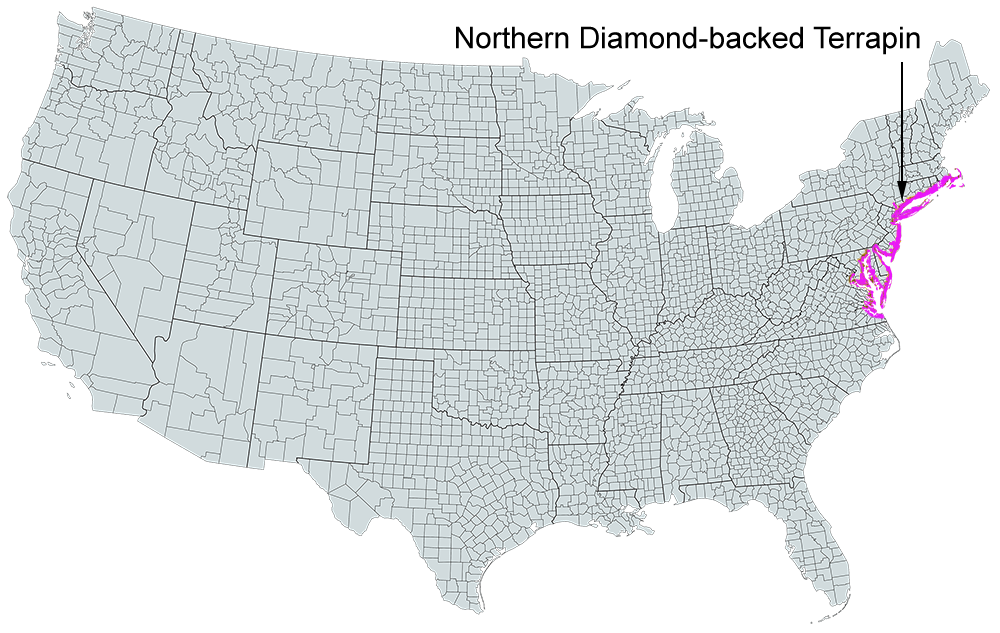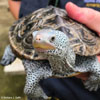Northern Diamond-backed Terrapin
Malaclemys terrapin terrapin
** Attention Crabbers **
Please consider adding Bycatch Reduction Devices to your crab pots to help save our native Northern Diamond-backed Terrapins.
Common Name: |
Northern Diamond-backed Terrapin |
Scientific Name: |
Malaclemys terrapin terrapin |
Etymology: |
|
Genus: |
Malaclemys is derived from the Greek word malakos which means "soft" and klemmys which means "tortoise". This refers to the hinged plastron. |
Species: |
terrapin is derived from the New Latin word terrapin meaning "turtle". |
Subspecies: |
terrapin is derived from the New Latin word terrapin meaning "turtle". |
Average Length: |
females 6 - 9 in. (15.2 - 22.9 cm), males 4 - 5.5 in. (10 - 14 cm) |
Virginia Record Length: |
8.4 in. (21.3 cm) |
Record length: |
9.1 in. (23 cm) |
Systematics: Originally described in 1793 as Testudo terrapin by Johann David Schoepff from specimens he saw in the Philadelphia market and in the coastal waters of Long Island. The type locality is "Habitat in America septentrionali... in foris Philadelphiae, ... in aquis subdulcibus Insulae Longae capto, . . . restricted to the coastal waters of Long Island, New York, by Schmidt (1953). The genus Malaclemys was erected for this turtle by Gray (1844). Considerable confusion has surrounded the species name. In the Virginia literature, Dunn (1918), Werler and McCallion (1951), and Reed (1958a) used Malaclemys centrata concentrica, following Siebenrock (1909). Hay (1902) and Brady (1925) used Malaclemmys. Dunn (1936) used Malaclemys terrapin concentrica, following Lindholm (1929). Reed (1957a), who thought the southern race occurred in Virginia, used Malaclemys terrapin centrata, following Mittleman (1944, 1945b). The current nomenclature has been used by all other Virginia authors. Only the nominate subspecies occurs in Virginia.
Description: A moderate-sized estuarine turtle reaching a maximum carapace length (CL) of 230 mm (9.1 inches) (Conant, 1975). In Virginia, known maximum CL is 213 mm, maximum plastron length (PL) is 189 mm, and maximum body mass is 1,625 g.
Morphology: Carapace wedge-shaped and smooth, widest part is posterior half of shell; series of concentric growth rings present in each scute; usually marginals 12/12, pleurals 4/4, and vertebrals 5, but 5 of 15 turtles from Chincoteague had 1-2 extra marginals; in some turtles, vertebrals have raised, rounded middorsal ridges (low keels), the posterior half of which are dark brown to black; hingeless plastron is 87-92% of CL.
Coloration and Pattern: Carapace gray, brown, yellowish, greenish, or nearly black; in many turtles the brown concentric circles alternate with gray, black, or yellow; ventral side of marginals and bridge possess concentric growth rings of black, brown, or yellow; venter yellowish to greenish, and often has an irregular pattern of black flecks; plastron may have a dark-brown blotch in each scute and margins of scutes may be outlined with thin black lines; skin usually gray in color; irregular pattern of small-to-large, comma- shaped flecks often present on head and limbs; eyes black and lips yellow. Nine of 20 specimens had a black mustache on the upper tomial surface (lip). The skin on the head and limbs is soft and pliable.
Sexual Dimorphism: There is strong sexual size dimorphism in this species. Virginia females averaged 179.3 ± 20.1 mm CL (125.3-213.0, n = 39) and 160.0 ± 19.9 mm PL (113.0-189.0, n => 30), and weighed an average of 1,089.5 ± 246.0 g (702- 1,625, n = 5). Males averaged 124.8 ± 10.9 mm CL (106.0-143.0, n = 19) and 103.2 ± 6.4 mm PL (91.0-114.1, n = 19), and weighed an average of 266.8 ± 37.7 g (242-323, n = 4). Sexual dimorphism index was 0.44. The precloacal distance in males was longer (ave. = 35.5 ± 4.7 mm, 31-42, n = 4) than in females (ave. = 20.0 ± 1.9mm, 17-22, n = 5). There are no sexual differences in color, pattern, or length of foreclaws.
Juveniles: Juveniles are patterned as adults but are light gray with yellow plastrons. Dark concentric lines occur on carapacial scutes, and dark lines outline plastral scutes. Average CL at hatching was 31.6 ± 1.0 mm (29.4-33.0, n = 36), average PL was 27.5 ±1.1 mm (24.4-29.0, n = 34), and mass was 7.1-8.7 g (ave. =7.9 ± 0.7, n = 28).
Confusing Species: This species may be confused with Chrysemys picta, which has 2 yellow spots behind each eye, yellowish transverse bands, and red markings on the marginal scutes. Chelydra serpentina has a brown, strongly serrated carapace and a long tail. Kinosternon subrubrum has a small brown carapace and a brown hinged plastron. All sea turtles have flippers and large heads.
Geographic Variation: None known in Virginia.
Biology: This is the only truly estuarine reptile in Virginia. It inhabits coastal, brackish marshes and their tributaries, bays, inlets, and tidal portions of coastal rivers. It is sometimes seen in the Atlantic Ocean. It is the only species in the family Emydidae that possesses a nasal salt gland used for excretion of excess salts in body fluids (Dunson, 1985). It is a commonly seen turtle on the ocean side of the Eastern Shore; comparatively fewer are seen in the Chesapeake Bay. Of 84 Virginia records, 96.9% occurred in March through October. These turtles usually overwinter in the mud in channels and tidal flats (Ernst and Barbour, 1972). Lawler and Musick (1972) reported a 46-mm-PL, 31-g juvenile that overwintered in a dune 0.3 m below the surface in Gloucester County.
The diet of M. terrapin consists mostly of estuarine mollusks. All samples examined from Virginia turtles contained mud snails (Nassarius obsoletus) (Dunson, 1985; J. C. Mitchell, pers. obs.). Other prey recorded for this species are periwinkles (Littorina irrorata), Nereis worms, fiddler crabs (Uca pugilator), and small clams (Melampus spp.) (Ernst and Barbour, 1972, 1989a). Adults are known to be killed and eaten by raccoons (Procyon lotor>) (Seigel, 1980). Eggs in nests on Chincoteague Island are consumed by raccoons, striped skunks (Mephitis mephitis), and possibly foxes (Vulpes, Urocyon) (W. A. Dunson, pers. comm.).
The reproductive cycle of this turtle has not been studied in Virginia. Mating occurs in spring in the Chincoteague area and is always in the water (Dunson, 1970). Nesting has been observed in Virginia between 30 May and 10 July. Burger and Montevecchi (1975) found that New Jersey turtles nested between 0700 and 1900 hours 10 June-23 July and that emergence from water was correlated with high tide. Nests are usually dug above the high-tide line, although W. A. Dunson (pers. comm.) found one below the tide line on Chincoteague Island. Nests are usually constructed in sand but may also be in fill dirt (Reid, 1955). In New Jersey, nest depth averaged 15 cm, depth to top of eggs 10.6 cm, egg compartment depth 4.7 cm, and egg compartment width 7.3 cm (Montevecchi and Burger, 1975). Average clutch size in populations from the Virginia barrier islands was 11.1 ± 2.5 (8-17, n = 13). A single clutch from Yorktown had 7 eggs (Reid, 1955). Females may lay more than one clutch per season as evidenced by enlarged follicles along with oviductal eggs in two females from Hog Island. The smallest mature female I measured was 113 mm PL and the smallest mature male was 91 mm PL. Age at maturity is not known for Virginia turtles. Egg size averaged 34.3 ± 1.6 x 21.2 ± 0.7 mm (length 32.3- 37.3, width 19.7-22.6, n = 144) and weighed 8.5 ± 1.2 g (5.9-11.1). Incubation time in the laboratory under variable temperatures was 65-70 days and at 28°C was 55-62 days (W. A. Dunson, pers. comm.). Laboratory hatching dates were 4-23 August. Hatchlings were observed in the dunes on Ship Shoal Island on 25 August 1987 (B. Truitt, pers. comm.).
The population ecology of this species is little known. Hildebrand (1932) estimated that individuals of M. terrapin live to at least 40 years of age. Males mature earlier (3 years) than females (4-7 years) in other parts of the range (Lovich and Gibbons, 1990).
In Virginia, hatchlings cannot grow in salinities above two-thirds seawater; they must be able to drink some fresh water in the first year of life (Dunson, 1985). Although adults can tolerate full-strength seawater, intake of freshwater is occasionally necessary to maintain proper salt balance in their tissues. Northern Diamond-backed Terrapins are known to drink rainwater as it runs off the marsh and from a puddle or spigot (Dunson, 1970,1985).
Remarks: Northern Diamond-backed Terrapins were harvested extensively for food from about 1880 to 1930, and many populations were nearly depleted (Ernst and Barbour, 1972). Considerable effort was made to propagate these turtles in captivity for the restaurant market (Coker, 1906; Hildebrand, 1929, 1932). The market declined after 1930, and there was little interest until recently. Asian populations in the United States have again created a demand for this species as a restaurant food item and in fish markets. Populations in the northeastern part of its range, including Virginia, are currently being harvested at unknown rates (Garber, 1988).
Blood characteristics were examined in 14 Virginia specimens of M. terrapin by Dorfman (1979). He found that the Virginia turtles had lower concentrations of plasma proteins and albumin than a sample of New Jersey turtles. This was attributed to the malnourished condition of the Virginia turtles; they had been purchased from a dealer in Chincoteague who fed them bread.
Northern Diamond-backed Terrapins often host barnacle infestations. Barnacles attach to all parts of the shell, but the carapace is the most common site. Barnacles may interfere with nesting and cause shell erosion and even death (Seigel, 1983). Seigel suggested that barnacles should be considered parasites rather than commensals, as they are usually termed.
Conservation and Management: The population status of this species is unknown in the Chesapeake Bay and in the Chincoteague area of Virginia. Trapping for the restaurant market (Dunson, 1970; Garber, 1988) and incidental capture and drowning of these turtles in crab pots, coupled with population ecology data, are needed immediately to provide information for decisions on harvest, size, and seasonal limits. This species was included in the special concern list in Mitchell (1991a).
References for Life History
Photos:
*Click on a thumbnail for a larger version.
Verified County/City Occurrence in Virginia
Accomack
Charles City
Gloucester
Isle of Wight
James City
King William
Mathews
New Kent
Northampton
Westmoreland
York
CITIES
Hampton
Newport News
Norfolk
Poquoson
Portsmouth
Suffolk
Virginia Beach
Verified in 11 counties and 7 cities.
U.S. Range

011_small.jpg)
002_small.jpg)










